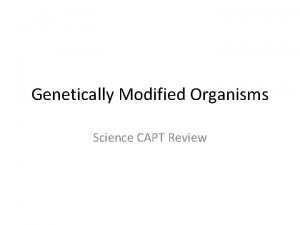Genetically Modified Organisms GMOs A Review Ronda Esper

- Slides: 1

Genetically Modified Organisms GMO’s: A Review Ronda Esper University of Texas at El Paso ABSTRACT HISTORY Genetically Modified Organisms (GMO’s) have been the source of many headlines in recent times, as scientist continue to explore the unknown areas of risk and potential benefits related to GMO’s. Science has not completely understood the potential adverse effects and harms which humans, various species and plants alike may be at risk for. This poster will explore adverse effects relating to GMO’s along with some of the benefits which we stand to reap from the scientific development of GMO’s. • The “Pusztai affair” was a study done to evaluate the effects of shortterm rat feeding with Genetically Modified potatoes expressing a gene developed to increase resistance to nematodes and insects. The result was mucosal thickness in the stomach of rats involved in the study compared with the control group. • The “Seralini Case” was a study to assess long-term toxicity of commercial formulation of a glyphosate an herbicide developed for use as weed control in corn. The outcome of this experiment was that the rats who were a part of this experiment developed mammary tumors in females and males developed liver congestion along with necrosis. CONCLUSIONS 1. The only methods available to the FDA for taking a product off the market is seizure, injunction or criminal prosecution. In the United States the FDA does not require a label on GM foods. 2. The Non-GMO project aids the public in their aim to keep transparency and labeling certain products as NON-GMO. 3. The European Council developed procedures and require developers to prove the safety of any new food “that has not been used for human consumption to a significant degree within the community”. In Europe companies cannot release food for consumers to purchase unless it has met the safety criteria. 4. The main takeaway about evaluation of GMO’s is that “The aim of science (truth) and risk analysis (safety) are not the same. ” Figure 3. GMO label NON- Figure 1. Process of creating a GMO REFERENCES . BACKGROUND • An organism is a biological entity and is capable of replication or transferring genetic materials • GM plants are organisms whose genomes have been modified by transferring extra genes or remodeling genes already present in the species. • The functions of GMO’s are to increase and diversify the knowledge on gene functions, improving genetics and creating selected compounds. • A transgene is a gene transferred from one gene to another either by natural or artificial mean • A recombinant gene or protein is the genetic material that has been formed by recombination of the DNA sequence or structure is the outcome of the process to form GMO’s • The initial breakthrough in GM technology though came in 1970 due to Herbert Boyer and Stanley Cohen’s contributions to Genetic Engineering Figure 2. The increase in the production of various GMO crops. . ACKNOWLEGEMENTS Research reported in this poster was supported by the assignment designations from the RWS 2 online course. Qaim, M. (2011). Chapter 2 Genetically Modified Crops and Global Food Security. Frontiers of Economics and Globalization Genetically Modified Food and Global Welfare, 29 -54. doi: 10. 1108/s 1574 -8715(2011)00000100072014). Retrieved July 5, 2016, from http: //www. cdc. gov/healthywater/drinking/public/water_disinfectio n. html Anliker, B. , Longhurst, S. , & Buchholz, C. (2009). Environmental risk assessment for medicinal products containing genetically modified organisms. Bundesgesundheitsblatt - Gesundheitsforschung Gesundheitsschutz Bundesgesundheitsbl. , 53(1), 52 -57. Retrieved February 25, 2016. Bartholomaeus, A. , Parrott, W. , Bondy, G. , & Walker, K. (2013). The use of whole food animal studies in the safety assessment of genetically modified crops: Limitations and recommendations. Critical Reviews in Toxicology, 43(Sup 2), 1 -24. doi: 10. 3109/10408444. 2013. 842955 De. Francesco, L. (2013). How safe does transgenic food need to be? Nature Biotechnology, 31(9), 794 -802. Retrieved February 25, 2016.

